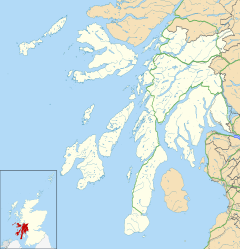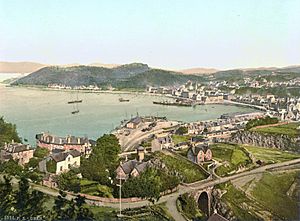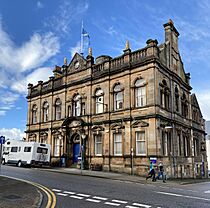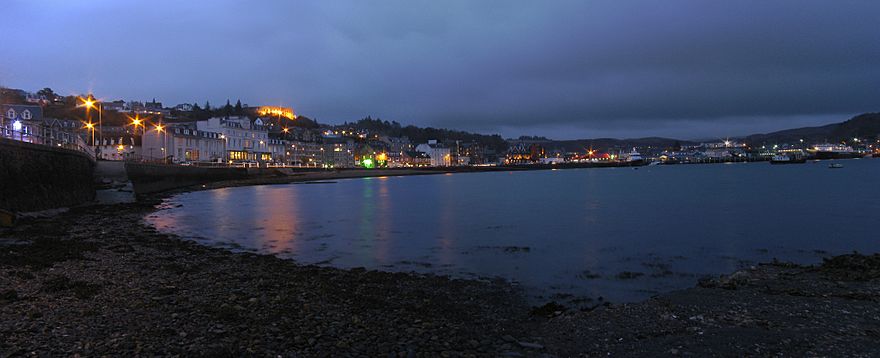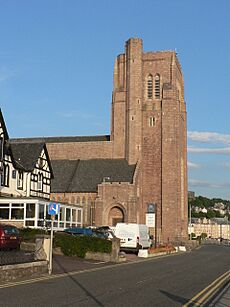Oban facts for kids
Quick facts for kids Oban
|
|
|---|---|
| Town and former burgh of barony | |
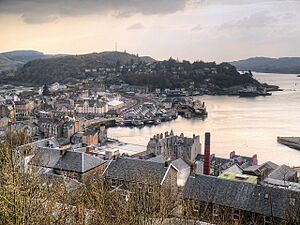 A view over Oban from McCaig's Tower |
|
| Population | Expression error: "Lua error in Module:Tabular_data at line 91: attempt to index field 'data' (a nil value)." must be numeric (2020) |
| OS grid reference | NM859298 |
| • Edinburgh | 93 mi (150 km) |
| • London | 402 mi (647 km) |
| Council area | |
| Lieutenancy area | |
| Country | Scotland |
| Sovereign state | United Kingdom |
| Post town | OBAN |
| Postcode district | PA34 |
| Dialling code | 01631 |
| Police | Strathclyde |
| Fire | Strathclyde |
| Ambulance | Scottish |
| EU Parliament | Scotland |
| UK Parliament |
|
| Scottish Parliament | |
Oban (pronounced OH-bən) is a lovely resort town in Scotland. Its name comes from the Scottish Gaelic "An t-Òban," which means The Little Bay. Even though it's not huge, Oban is the biggest town between Helensburgh and Fort William. During the busy tourist season, its population can grow to over 24,000 people! Oban is nestled in a beautiful horseshoe-shaped bay. This bay is naturally protected by the island of Kerrera and, further out, the Isle of Mull. To the north, you can see the island of Lismore and the tall mountains of Morvern and Ardgour.
Contents
Ancient History of Oban
Humans have lived in the area where Oban is now for a very long time. We know this from old tools and remains found in caves. These finds date back to the Mesolithic period, which was thousands of years ago. Just outside Oban, you'll find Dunollie Castle. This castle stands on a spot that has been used for defense since the Bronze Age. It guards the main entrance to the bay.
North of Oban, at a place called Dunstaffnage, archaeologists found even more proof of ancient life. In 2010, they discovered signs that people lived there from the Stone Age all the way to early historical times. They found old burial sites used for many generations during the Late Iron Age. They also found a farm that was active between the late 600s and 800s AD.
Oban's Development Through Time
Before the 1800s, Oban was a very small place. Only a few families lived there, working in fishing, trading, shipbuilding, and quarrying. Some brave tourists also visited. A trading company set up a storehouse around 1714. This helped Oban become a place where ships could clear their papers for herring fishing by 1736.
The modern town of Oban really started to grow when the whisky distillery opened in 1794. In 1811, the town was officially made a burgh of barony by the King. Famous writer Sir Walter Scott visited in 1814. His poem, The Lord of the Isles, made many more people want to visit Oban. The town became a Parliamentary Burgh in 1833.
A railway line, the Callander and Oban Railway, was approved in 1864. It took several years to build, but the final part opened on June 30, 1880. This railway brought more wealth to Oban. It helped local businesses and made tourism even more popular. Around this time, work also began on the Oban Hydro, a project that was stopped because it cost too much.
Work on McCaig's Tower, a famous landmark, started in 1895. John Stewart McCaig paid for it to give jobs to local stonemasons during tough times. However, construction stopped in 1902 when he passed away. The Oban Municipal Buildings were finished around 1900.
Glencruitten House, a Scottish-style castle, was built in 1897. It was changed a lot in 1903 and a library was added in the late 1920s. The house has been owned by the MacKay family for four generations since 1917. They were known for collecting art.
During World War II (1939–1945), Oban was a very important base for merchant and Royal Navy ships. It played a key role in the Battle of the Atlantic. There were signal stations, anti-submarine systems, and even a controlled minefield in the Sound of Kerrera. The Royal Air Force also had a flying-boat base and an airfield nearby.
Oban was also important during the Cold War. The first Transatlantic Telephone Cable (TAT-1) came ashore here. This cable carried the special "Hot Line" between the leaders of the United States and the Soviet Union.
Since the 1950s, tourism has been Oban's main industry. The town is also a busy ferry port. It's the main place for Caledonian MacBrayne ferries heading to many of the Hebrides islands. The Royal National Lifeboat Institution opened the Oban Lifeboat Station in 1972 to help people at sea.
Oban's Weather
Like the rest of the British Isles, Oban has a maritime climate. This means it has cool summers and mild winters. The closest official weather station is at Dunstaffnage, about 2.7 miles (4.3 km) north-north-east of Oban. It rains a lot, but thanks to the Gulf Stream, the temperature rarely drops below freezing.
| Climate data for Dunstaffnage (1991-2020 normals, extremes 1972-2022) | |||||||||||||
|---|---|---|---|---|---|---|---|---|---|---|---|---|---|
| Month | Jan | Feb | Mar | Apr | May | Jun | Jul | Aug | Sep | Oct | Nov | Dec | Year |
| Record high °C (°F) | 13.9 (57.0) |
14.9 (58.8) |
18.7 (65.7) |
23.7 (74.7) |
27.2 (81.0) |
29.1 (84.4) |
29.3 (84.7) |
28.6 (83.5) |
25.9 (78.6) |
20.1 (68.2) |
17.0 (62.6) |
14.8 (58.6) |
29.3 (84.7) |
| Mean daily maximum °C (°F) | 7.5 (45.5) |
7.8 (46.0) |
9.3 (48.7) |
11.9 (53.4) |
14.9 (58.8) |
16.8 (62.2) |
18.2 (64.8) |
18.1 (64.6) |
16.2 (61.2) |
13.1 (55.6) |
10.0 (50.0) |
8.0 (46.4) |
12.7 (54.8) |
| Mean daily minimum °C (°F) | 2.7 (36.9) |
2.6 (36.7) |
3.4 (38.1) |
5.0 (41.0) |
7.1 (44.8) |
9.6 (49.3) |
11.4 (52.5) |
11.4 (52.5) |
9.9 (49.8) |
7.5 (45.5) |
5.0 (41.0) |
2.9 (37.2) |
6.5 (43.8) |
| Record low °C (°F) | −8.7 (16.3) |
−7.2 (19.0) |
−6.0 (21.2) |
−3.9 (25.0) |
−1.9 (28.6) |
0.8 (33.4) |
4.2 (39.6) |
2.7 (36.9) |
−0.6 (30.9) |
−2.3 (27.9) |
−4.2 (24.4) |
−8.3 (17.1) |
−8.7 (16.3) |
| Average precipitation mm (inches) | 206.2 (8.12) |
156.0 (6.14) |
137.1 (5.40) |
91.6 (3.61) |
94.9 (3.74) |
95.8 (3.77) |
109.9 (4.33) |
129.9 (5.11) |
140.9 (5.55) |
189.3 (7.45) |
178.3 (7.02) |
197.9 (7.79) |
1,727.9 (68.03) |
| Average precipitation days (≥ 1 mm) | 20.5 | 17.4 | 17.4 | 13.8 | 13.8 | 14.2 | 15.7 | 16.8 | 16.3 | 19.0 | 19.7 | 19.6 | 204.1 |
| Mean monthly sunshine hours | 32.4 | 62.6 | 94.9 | 147.2 | 192.1 | 171.0 | 135.0 | 135.4 | 99.1 | 77.7 | 46.3 | 33.3 | 1,227 |
| Source 1: Met Office | |||||||||||||
| Source 2: CEDA Archive (extremes) | |||||||||||||
Oban's Culture and Traditions
The local culture in Oban is strongly connected to Gaelic traditions. In 2011, about 8.2% of the town's population over age 3 could speak Gaelic. Even more, 11.3%, had some understanding of the language. Oban is known as the birthplace of the Royal National Mòd. This important festival celebrates Gaelic language, music, and culture. It was first held in Oban in 1892. The town hosted the 100th Mòd in 2003 and the most recent one in October 2024. These events bring thousands of performers and visitors to Oban.
An annual Highland Games, called the Argyllshire Gathering, also takes place in the town. This event features traditional Scottish sports and music. The Corran Halls theatre is a place for community events, local shows, and touring groups like Scottish Opera.
Oban has a two-screen cinema called the Phoenix Cinema. It reopened in August 2012 thanks to local efforts. Oban has also been a filming location for movies like Ring of Bright Water and Morvern Callar.
You can learn about Oban's past at the Oban War and Peace Museum. It shows items from the town's history during peacetime and wartime. There's also a museum inside the Oban Distillery, where you can learn about how whisky has been made there since 1794. The Hope MacDougall collection shares stories about how people in Scotland used to live and work.
Music is a big part of Gaelic culture in Oban. The local Oban High School Pipe Band has won major competitions, including the World Pipe Band Championships. The town also has a successful senior pipe band and a Gaelic choir that competes regularly.
Fun Places to Visit in Oban
The most famous landmark in Oban is McCaig's Tower. You can see it from many parts of the town. Construction of this tower began in 1897. It was paid for by John Stuart McCaig to give jobs to local stonemasons. He also wanted it to be a lasting memory for his family. Work stopped in 1902 when he died.
The area around Oban has amazing coastal and mountain scenery. You can also visit historic castles and ancient religious sites. North of town, there's a natural rock formation called Fingal's Dogstone. Legend says it's connected to the Giant's Causeway in Northern Ireland.
The Oban Visitor Information Centre used to be on the North Pier. It provided details about local attractions. The Oban & Lorn Tourism Alliance also shares information on its website.
Getting Around Oban
Oban is at the western end of the A85 road. ScotRail trains run daily between Oban railway station and Glasgow Queen Street. The town is a very important ferry port. It's Caledonian MacBrayne's busiest terminal. Oban is often called the "Gateway to the Isles." Ferries sail from here to islands like Lismore, Colonsay, Islay, Coll, Tiree, and Mull. There are also ferries to Barra and South Uist. A new ferry terminal opened in 2005, and a second loading ramp in 2007. This allows two ferries to load or unload at the same time.
Scottish Citylink buses travel from Glasgow several times a day. In summer, you can also find buses from Dundee and to Edinburgh. West Coast Motors runs many local bus services. They also have longer coach routes to places like Lochgilphead and Fort William.
In the past, Oban had direct passenger train services to Edinburgh. These lines were closed in 1965 and 1966.
Oban also has an airport located outside the village of North Connel. It's about 5 miles (8 km) northeast of the town. The airport has regular flights to Islay, Colonsay, and Tiree. These flights take only about half an hour. The only airline flying from Oban Airport is Hebridean Air Services.
Education in Oban
Oban has a primary school campus in the south of town and Park Primary School in the north. It also has a large high school, Oban High School. In 2019, a new £36 million building was built for the high school. The old 1890 building was then taken down.
Students from a wide area attend Oban High School. Some students travel long distances every day. Students who live on nearby islands like Coll or Mull stay at a local hostel during the school week. The school helps fund this hostel so families don't have to pay.
The building that used to be Rockfield Primary School is now used by the community. It is being updated and has also been used as a place for voting.
Media in Oban
Television signals in Oban come from the Torosay and local relay transmitters.
For many years, Oban FM was the town's local radio station. It broadcast local news and entertainment. The station stopped broadcasting in July 2024. In late 2024, Nevis Radio announced it would start broadcasting in Oban from 2025 on 103.3FM. This was the same frequency Oban FM used.
BBC Radio Scotland can be heard in the town on 93.3 FM.
The Oban Times is the local weekly newspaper. It is published every Thursday.
Churches in Oban
Oban has several churches. The Kilmore & Oban Parish Church is part of the Church of Scotland. It has two church buildings.
The main church of the Roman Catholic Diocese of Argyll and the Isles is St Columba's Cathedral. It is located at the north end of the Esplanade. This cathedral was designed by Sir Giles Gilbert Scott and built between 1932 and 1959.
The Scottish Episcopal Church is represented by the Cathedral Church of St John the Divine. It is one of two cathedrals for the Diocese of Argyll and the Isles.
Other churches in Oban include the Free Church of Scotland, the Baptist Church, Salvation Army, Elim Pentecostal Church, The Church of Jesus Christ of Latter-day Saints, and the Lorn Christian Fellowship. There is also the Associated Presbyterian Church and the Congregational Church. A Kingdom Hall of Jehovah's Witnesses is located nearby in Dunbeg.
Cemeteries
Pennyfuir Cemetery, north of Oban, is where several notable people are buried. This includes Frances Shand Kydd, who was the mother of Diana, Princess of Wales.
Sports and Activities in Oban
Oban's location near mountains and the sea means there are many sports and activities to enjoy. These include scuba-diving, coasteering, sailing, mountain biking, and winter mountaineering.
The local amateur football team is Oban Saints. They have a small stadium in Mossfield. However, shinty is a more popular sport locally. Oban has two major shinty teams, Oban Camanachd and Oban Celtic. The Oban Times newspaper even has a "Spot the Shinty Ball" competition each week.
Oban Cricket Club started in 2003 and plays in nearby Taynuilt. Oban Lorne Rugby Football Club celebrated its 50th anniversary in 2012. Glencruitten Golf course was designed by famous golfer James Braid in the early 1900s. It offers a challenging 18 holes.
The West Highland Tennis Championships are held every July. They attract some of Scotland's best players. Past champions include Colin Fleming and Judy Murray.
Oban also has a lively martial arts scene. You can find classes for karate, kick boxing, mixed martial arts, and boxing.
Water sports are very popular in this seaport town. Sailing is a big activity, and West Highland Week brings sailors from all over the world to Oban each year. A raft race is also held regularly in the bay. Scuba diving is also popular, especially wreck diving in the Sound of Mull. Even if the weather changes, there's always a good spot to dive nearby.
Famous People from Oban
- Jamie Campbell-Walter, racing driver
- Robert MacIntyre, professional golfer
- John McPhee, Grand Prix motorcyclist
- Susan Partridge, long-distance runner
- Susie Wolff, professional racing driver
Oban's Twin Towns
Oban has two twin towns. In 1993, Laurinburg, North Carolina, in the United States, became a twin town. Students from Oban High School take part in a yearly exchange with students from Scotland High School in Laurinburg. In 1997, Oban also became twinned with Gorey, County Wexford, Ireland.
See also
 In Spanish: Oban para niños
In Spanish: Oban para niños


